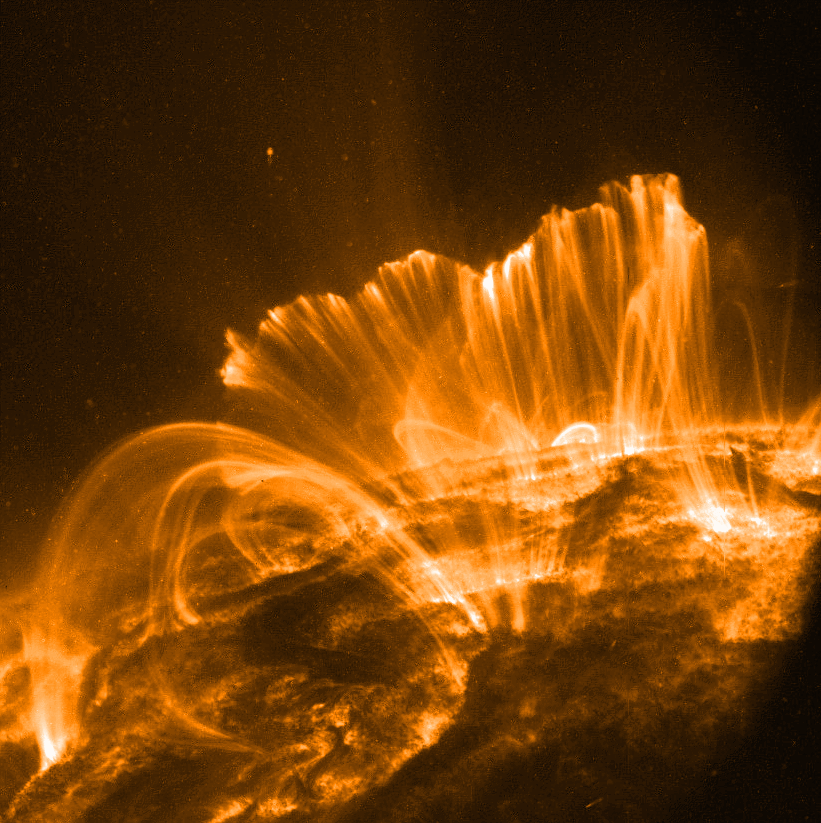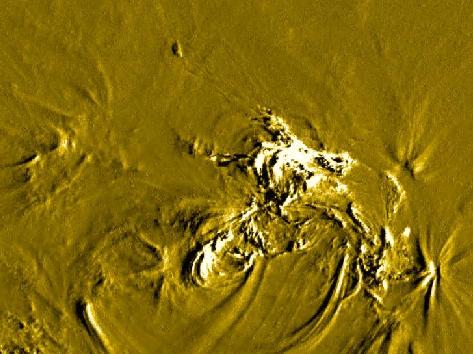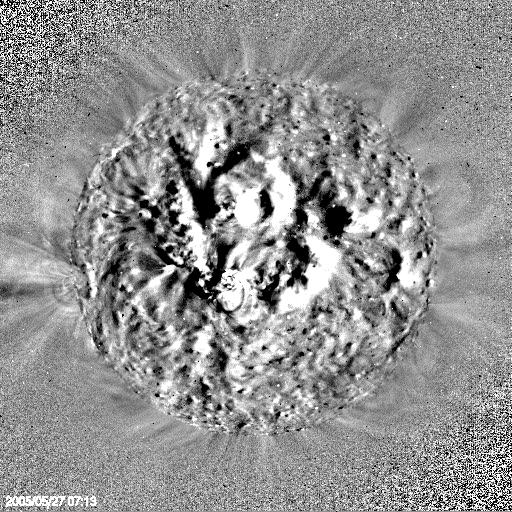Arcades
© Charles ChandlerAfter a solar flare, sunspot pairs frequently become connected by coronal loops, known collectively as arcades. Robust loops are more likely to occur if 10~24 hours before the flare, there is a significant increase in the number of high energy protons ejected by microflares.1 In the present model, the ejection of protons thins out the positive double-layer clinging to the solar cathode, encouraging the primary current out into space. Greater current densities in the sunspot shafts develop more powerful magnetic fields that keep the currents organized, which prevents discharges into their positively charged sheaths. This allows the electric fields to develop to extreme limits before flares occur, meaning much more powerful CMEs. And the consequence of a CME is that positive ions are ejected into space, creating a charge disparity between the sunspots. Electric currents discharging that potential will follow the magnetic lines of force, producing coronal loops.Interestingly, the coronal loops show up best in 284 Å emissions from Fe XV, which is iron that is missing 14 electrons. This is interesting because hydrogen is about 30,000 times more abundant than iron in the granular layer and lower corona,2 meaning that these loops should show up far better in H-α emissions, but which aren't present at all.Figure 1. Coronal loops seen in 284 Å emissions, produced by Fe XV, sprouting out of what is sometimes called "solar moss" (i.e., the irregular surface of the Sun seen in iron emissions). Note that in single-frequency imagery, brightness doesn't mean temperature, but rather, just ion density.We know that these coronal loops match up exactly with magnetic lines of force. We also know that magnetic fields don't produce photons, but electric currents do (assuming that there are atomic nuclei in the way). So these are B-field-aligned electric currents that reconcile charge disparities between sunspots,3,1:9 usually and most vigorously after the arc discharge in a solar flare, and with a current density of 1~3 A/m2.1:11We might be tempted to say that the currents prefer concentrations of iron because of its conductivity, but all of the plasma in the Sun is a near-perfect conductor. So the conductivity of the far more abundant hydrogen should serve the purpose just fine, and we still have no explanation for the presence of iron emissions, and the absence of hydrogen emissions.We might also think that iron would be more attracted by the magnetic field, and hence get drawn into the filaments, but ionized iron is not magnetic. Furthermore, even if it was, it would move toward the poles, and it would not form continuous loops. Magnetic fields can only accelerate magnetized particles where the lines of force are converging, and the acceleration is only in the direction of the convergence. Hence the particles aren't going to flow out of one pole and into the other, as we see in these arcades.The only relevant property of iron plasma is simply that it is capable of higher degrees of ionization than hydrogen. At the end of the CMEs section it was noted that we can expect the positively charged sheath around a sunspot shaft to contain an inordinate amount of highly ionized iron, as it is capable of responding much more vigorously to the electric field. In short, the Fe XV pushes the H+ out of the way, as it is motivated by 14 times more force. The concentration of iron in the current sheath then explains its inordinate abundance in CMEs. This also means that after the flare and the CME, if coronal loops form, they will connect two regions that are rich in iron. These atoms can then get sucked up into the loops, in one direction by electron drag, and in the other simply by the electric force.The next question concerns the temperature. Fe XV is typically estimated to be over 2 MK. The assumption there is that the only thing that can knock an electron off of an atom is atomic motion. We can then estimate the atomic motion (i.e., temperature) by the degree of ionization. This is convenient for extremely high temperatures that cannot be measured any other way, and for estimating temperatures of distant objects (such as the Sun). But it may be just a little too convenient, and perturbing factors might be getting overlooked. The reality is that temperature isn't the only thing that can ionize plasma. Powerful electric fields do the same thing, and these actually remove degrees of freedom, thereby lowering the temperature instead of raising it.4 This isn't taken into account because there is no way to measure an electric field from a distance. But when we see things that just don't make sense when temperature is estimated just by the degree of ionization, we have to remember that this might be evidence not of high temperatures, but of powerful electric fields. As concerns coronal loops, it's hard to imagine how filaments can persist, sometimes for hours, at >2 MK, without getting blown apart by the pressure from the extreme temperature, especially considering the fact that they are surrounded by a near-perfect vacuum. It's more likely that the temperature is far less, and that the iron concentrations are maintained by the electric and magnetic forces.Further to the point, we also have good imagery of 171 Å emissions from Fe IX and Fe X (i.e., iron missing 8 or 9 electrons). (See Figure 2.) We see the same affinity for active regions. But we also see a solid background of iron emissions in the quiet areas. (Note that the 3D effect comes from post-processing, and is not an indication of altitude. The raw data simply registered ion densities. These were made easier to visualize by brightening the gradients facing in one direction, and darkening them in the other, creating the 3D effect.)The ionic temperature of Fe IX/X is about 1.5 MK. But why would the iron be so hot in the quiet areas, when the surrounding hydrogen is only 6000 K? Here we have to remember that hydrogen is 30,000 times more abundant than iron in the granular layer. This means that iron atoms are 30,000 times more likely to bump into hydrogen atoms than other iron atoms, and all of the atomic motions (i.e., temperatures) should be well distributed among all of the elements present. If the ionization cannot be attributed to temperature, it can only be proof of a powerful electric field.On a much larger scale, we see patterns in 195 Å emissions from Fe XII that sometimes persist for days, or even weeks, in a recognizable form. This is suggestive of physical structures inside the Sun.But again, hydrogen is 30,000 times more abundant than iron in the granular layer. Persistent concentrations of iron ions in the Sun do not reveal the topography of structural features any more than clouds in the Earth's atmosphere do. What we're seeing is iron atoms suspended in hydrogen plasma. We see the iron because we're filtering only for iron emissions, which hydrogen cannot block.Nevertheless, the ion concentrations give us an enormous amount of information. When interpreted as evidence of electric fields, and when correlated with coronagraphs, we get a more complete picture of the electric currents that power the Sun. The ions reveal increases in the local electric field, due to equatorial thinning of the positive double-layer, and due to the depletion of positive ions by CMEs.
References
1. Ryutova, M. P.; Frank, Z.; Hagenaar, H.; Berger, T. (2011): Flares Producing Well-organized Post-flare Arcades (Slinkies) Have Early Precursors. The Astrophysical Journal, 733 (2): 125 ⇧ ⇧ ⇧
2. Anders, E.; Grevesse, N. (1989): Abundances of the elements: Meteoritic and solar. Geochimica et Cosmochimica Acta, 53 (1): 197-214 ⇧
3. Ryutova, M. (2006): Coupling effects throughout the solar atmosphere: 2. Model of energetically open circuit. Journal of Geophysical Research, 111 (A9): A09102 ⇧
4. Caflisch, R. et al. (2008): Accelerated Monte Carlo Methods for Coulomb Collisions. Bulletin of the American Physical Society, 53 (14) ⇧













